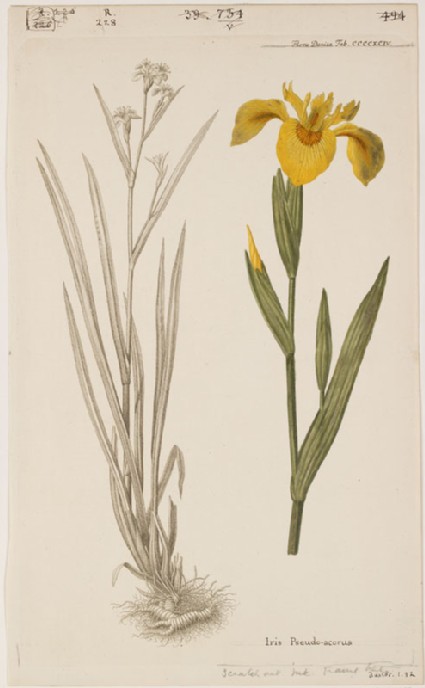Browse: 1470 objects
- Reference URL
Actions
The Golden Iris (Iris Pseudo-acorus) (from the Floræ Danicæ) anonymous Danish
-
Details
- Artist/maker
-
anonymous Danish (engraver)
- Object type
- Material and technique
- watercolour and bodycolour over engraving on laid paper
- Dimensions
- 337 x 211 mm (plate); 365 x 223 mm (sheet)
- Inscription
- Recto:
within the plate:
top right corner, engraved, above a graphite guide-line: Flora Danica Tab. CCCCXCIV.
bottom, towards left, in ink, within ruled graphite horizontal lines: Iris Pseudo-acorus
outside the plate:
top left, in ink, within a rectangular box, crossed out: R./226
just to the right, in ink, crossed out: 226
just to the right of this, in ink: R. | 228
top centre, in ink, crossed out: 39 . 734/V
top right corner, in ink, crossed out: 494
bottom margin, from centre to right, in graphite, below a graphite guide-line: Scratch out Ink. Frame here
bottom right, in ink: Baxter. 1.82
Verso, bottom left, the Ruskin School's stamp
On a separate small paper label, in graphite: R | 228
- Provenance
-
Presented by John Ruskin to the Ruskin Drawing School (University of Oxford), 1875; transferred from the Ruskin Drawing School to the Ashmolean Museum, c.1949.
- No. of items
- 1
- Accession no.
- WA.RS.RUD.228
-
Subject terms allocated by curators:
Subjects
-
References in which this object is cited include:
References
Ruskin, John, The Ruskin Art Collection at Oxford: Catalogue of the Rudimentary Series, in the Arrangement of 1873, ed. Robert Hewison (London: Lion and Unicorn Press, 1984), cat. Rudimentary no. 228, RUD.228
Oeder, George Christian, et al., Icones plantarum sponte nascentium in regnis Daniæ et Norvegiæ, in ducatibus Slesvici et Holsatiæ, ... Floræ Danicæ nomine inscriptum, 23 (Copenhagen: Claudius Philibertus, 1764-1883), vol. III (1770), pl. 494
Ruskin, John, Instructions in Practice of Elementary Drawing, Arranged with Reference to the First Series of Examples in the Drawings Schools of the University of Oxford (n.p., [1872]), cat. Rudimentary no. 228
Ruskin, John, Instructions in the Preliminary Exercises Arranged for the Lower Drawing-School (London: Smith, Elder, 1872), cat. Rudimentary no. 228
Ruskin, John, Instructions in the Preliminary Exercise Arranged For the Lower Drawing-School (London: Spottiswoode, 1873), cat. Rudimentary no. 228
Ruskin, John, ‘The Ruskin Art Collection at Oxford: Catalogues, Notes and Instructions’, Edward T. Cook and Alexander Wedderburn, eds, The Works of John Ruskin: Library Edition, 39 (London: George Allen, 1903-1912), 21, cat. Rudimentary no. 228
Location
-
- Western Art Print Room
Position in Ruskin’s Collection
Ruskin's Catalogues
-
Ruskin's Rudimentary series, 3rd ed. (1872)
R|228} The Golden Iris. Floræ Danicæ. -
Ruskin's Rudimentary series 4th ed. (1872)
R|228} The Golden Iris. Floræ Danicæ.
Secondly, for the group of Irids.
R. 228. The Golden Iris; (Water-flag.)Here in Oxford, where it grows everywhere near us, we must take this for our own type of the Fleur-de-lys, and the rather that I believe this to be Pindar’s water-flag, the true Ion. The plate is from the Floræ Danicæ.
-
Ruskin's Rudimentary series, 5th ed. (1873)
R|228} The Golden Iris. FFloræ Danicæ.
Secondly, for the group of Irids.
R.228. The Golden Iris; (Water-flag.)Here in Oxford, where it grows everywhere near us, we must take this for our own type of the Fleur-de-lys, and the rather that I believe this to be Pindar’s water-flag, the true Ion. The plate is from the Floræ Danicæ.






